DIY Cold Closet Project
+6
JudyB
Khaimraj Seepersad
Kevin S - Wisco Bonsai
appalachianOwl
tmmason10
KyleT
10 posters
Page 1 of 2
Page 1 of 2 • 1, 2 
 DIY Cold Closet Project
DIY Cold Closet Project
I've been training some sub-tropicals for a few years, but this summer I took the Bonsai Plunge and collected about 15 deciduous and conifer trees. In November I built a cold closet to over-winter the trees, and I thought I would share my project. Since this is my first over-wintering effort, I would love any feedback and suggestions.
I live in Milwaukee, Wisconsin, which gets pretty cold, and I don't have a garage or a yard. Fortunately, I do have a basement, so I built my cold closet there. My basement has a concrete floor and concrete block walls. It has glass block windows with vents.
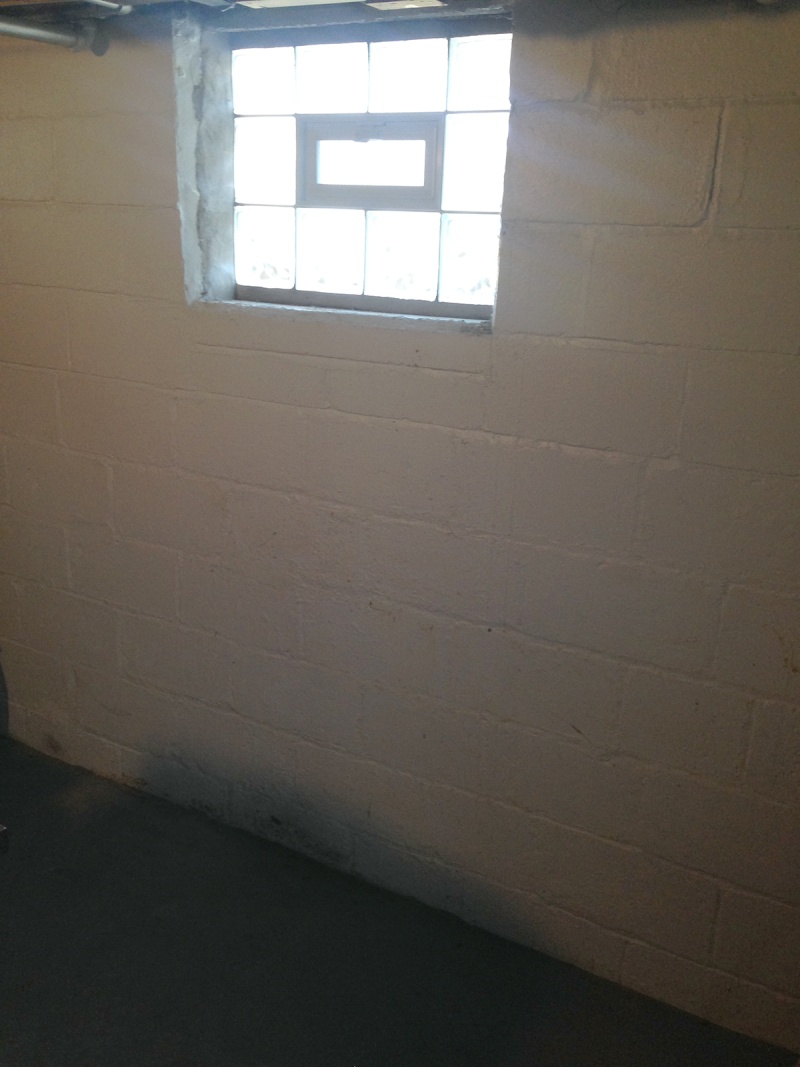
The temperature in my basement gets down to about 48F in January, which is not enough to keep trees dormant, so the challenge is to get it down to 33F. To do this, I built the closet up against the wall of the basement, around one of the windows. With the window's vent closed, the temperature in the closet goes up to about 48F, like the rest of the basement. By opening the vent to varying degrees, I can get the temperature as low as 30F.
I made the closet out of five 4ft x 8ft sheets of 3/4 inch thick rigid foam insulation. Here's a photo of a typical fabrication detail.
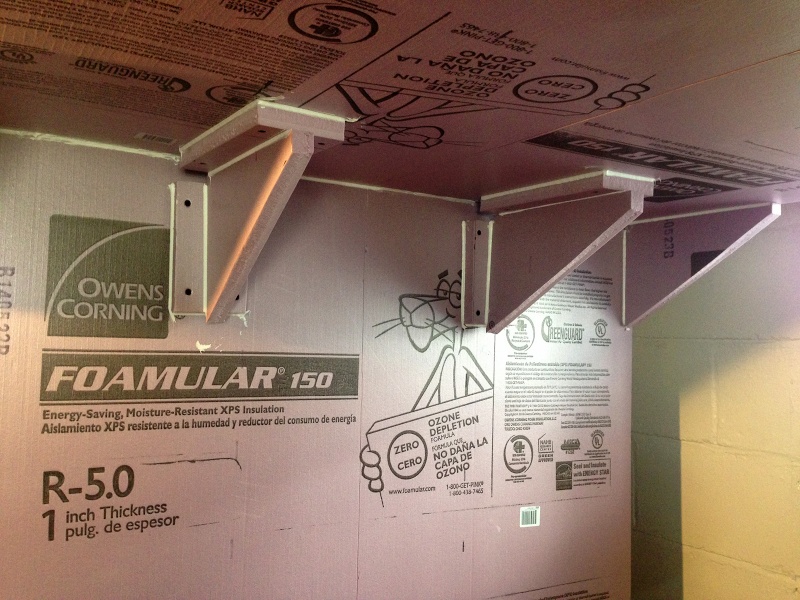
The key to making the whole thing out of rigid foam is the connections. I made a bunch of foam brackets, then screwed them to the wall and ceiling panels of the closet with drywall screws.
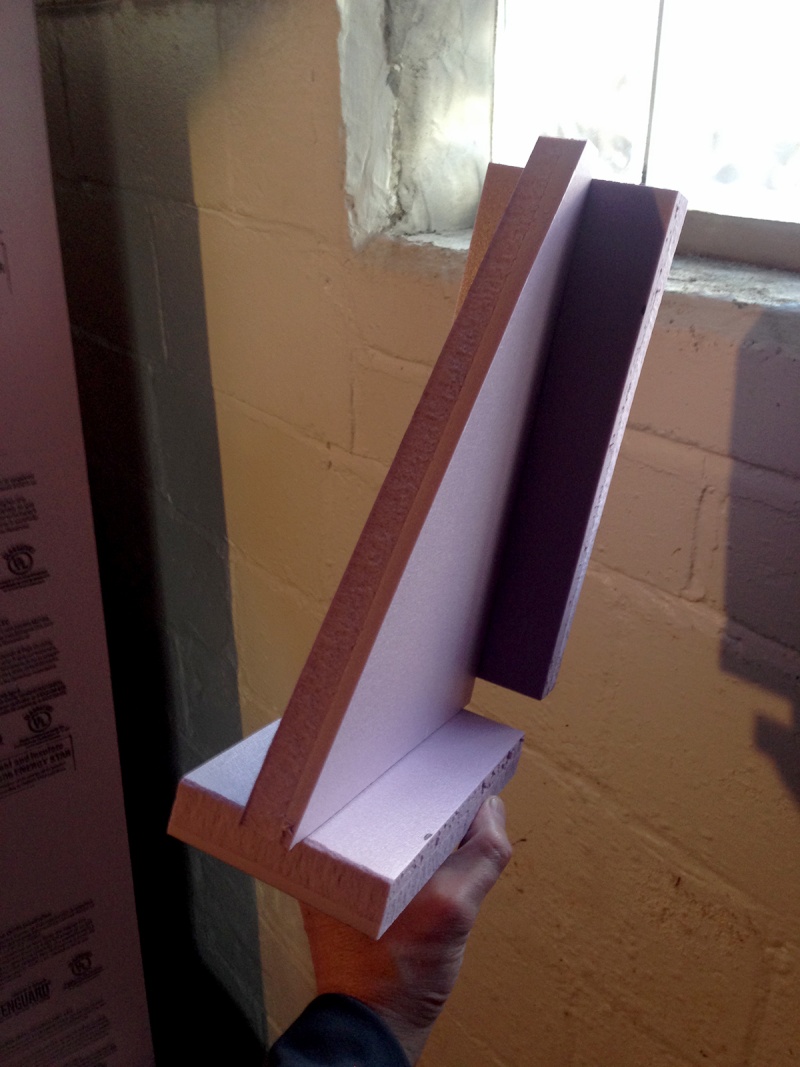
After it is all screwed together, which goes really fast, I used adhesive caulk around all the seams and corners, to both strengthen the joints and also to get a good air seal for the closet. It took about eight hours to fabricate the closet, and it cost about $130. I used some picnic table benches and an old garden table as shelves in the completed closet.
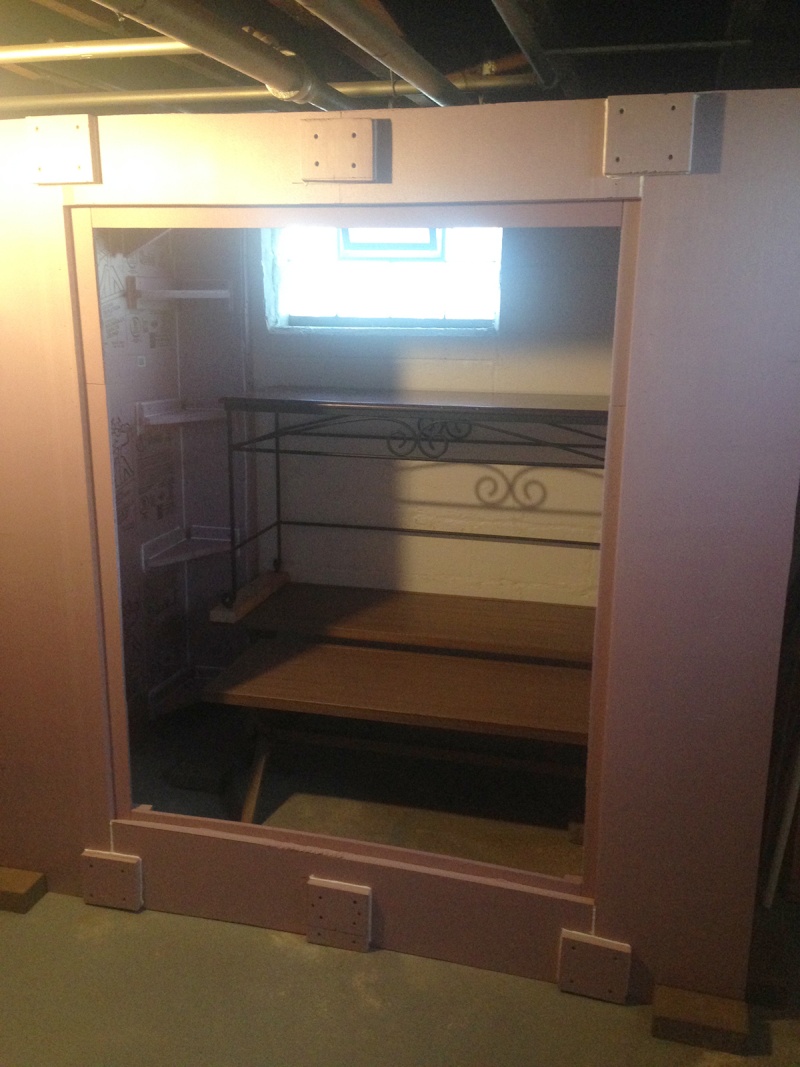
I have 15 trees in there this winter, but it has about a 20 tree capacity. Maybe a few more if I stuff them. Here it is loaded with trees.
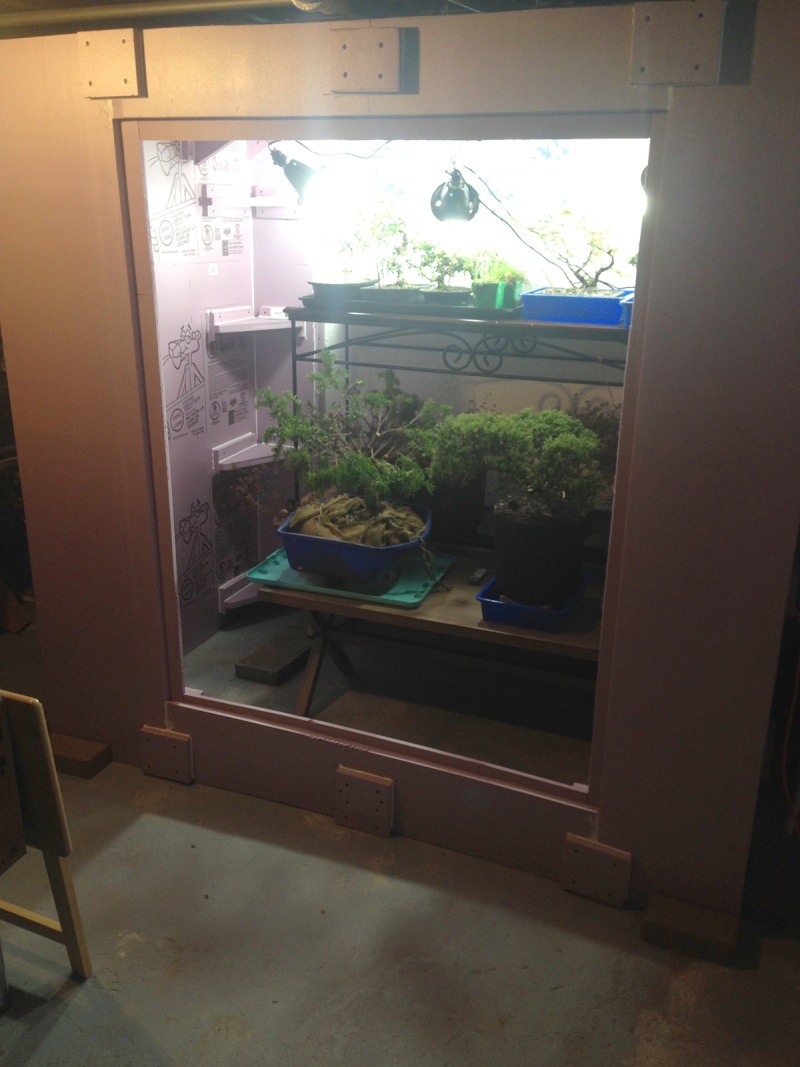
I have three grow lights in there and a fan for air circulation. The lights are on a timer, since they create enough heat to raise the temperature above 40F if the outside temperature is on the warm side. I also have a Bluetooth temperature sensor located at the coldest position in the closet. This sensor sends my smartphone an alert if the temperature falls to 33F, so I can take action to ensure that the temp stays above freezing. So far, I've been successful keeping the temperature right at 34F-35F. My plan is to keep it there through January and February, not dropping the trees below freezing at any time.
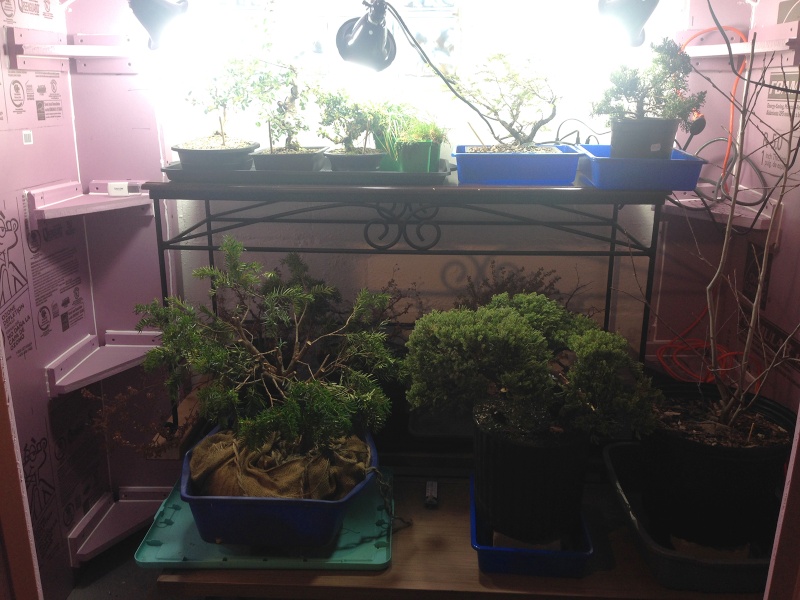
I live in Milwaukee, Wisconsin, which gets pretty cold, and I don't have a garage or a yard. Fortunately, I do have a basement, so I built my cold closet there. My basement has a concrete floor and concrete block walls. It has glass block windows with vents.

The temperature in my basement gets down to about 48F in January, which is not enough to keep trees dormant, so the challenge is to get it down to 33F. To do this, I built the closet up against the wall of the basement, around one of the windows. With the window's vent closed, the temperature in the closet goes up to about 48F, like the rest of the basement. By opening the vent to varying degrees, I can get the temperature as low as 30F.
I made the closet out of five 4ft x 8ft sheets of 3/4 inch thick rigid foam insulation. Here's a photo of a typical fabrication detail.

The key to making the whole thing out of rigid foam is the connections. I made a bunch of foam brackets, then screwed them to the wall and ceiling panels of the closet with drywall screws.

After it is all screwed together, which goes really fast, I used adhesive caulk around all the seams and corners, to both strengthen the joints and also to get a good air seal for the closet. It took about eight hours to fabricate the closet, and it cost about $130. I used some picnic table benches and an old garden table as shelves in the completed closet.

I have 15 trees in there this winter, but it has about a 20 tree capacity. Maybe a few more if I stuff them. Here it is loaded with trees.

I have three grow lights in there and a fan for air circulation. The lights are on a timer, since they create enough heat to raise the temperature above 40F if the outside temperature is on the warm side. I also have a Bluetooth temperature sensor located at the coldest position in the closet. This sensor sends my smartphone an alert if the temperature falls to 33F, so I can take action to ensure that the temp stays above freezing. So far, I've been successful keeping the temperature right at 34F-35F. My plan is to keep it there through January and February, not dropping the trees below freezing at any time.


KyleT- Member
 Re: DIY Cold Closet Project
Re: DIY Cold Closet Project
Very nicely done and great idea! I imagine this should keep your trees happy and healthy this winter. Thanks for sharing.
tmmason10- Member
 Re: DIY Cold Closet Project
Re: DIY Cold Closet Project
That is pretty dang neat! I like it. This should really aid in the survival of your collected material.
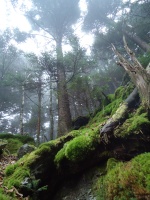
appalachianOwl- Member
 Re: DIY Cold Closet Project
Re: DIY Cold Closet Project
wow kyle... that looks really good... well thought out and constructed.
not only can you design it, but you can build it too !
are those corner supports strong enough to hold a plant ?
if so, bonus.
also didja insulate between the floor joists ?
even though cold air falls and hot rises, it might help stabilize your temps more.
(not to mention protecting whatever mechanicals are running in the ceiling above your closet)
it's hard to see whats on that top shelf, but if its deciduous they won't need the light as much as your conifers (which don't need much, but they do need some and you probably already knew that)... crowd 'em around that window, if it faces other than north...
and dont be too a-feared of a freeze, most of what you have can probably take it, and since joining this forum i have read about some trees surviving in surprisingly scant over-wintering conditions... (i.e stuck under a bench outside... forgot about outside until spring, etc)
lastly, speaking of the forum, welcome aboard and glad you came to play in the sand-box.
not only can you design it, but you can build it too !
are those corner supports strong enough to hold a plant ?
if so, bonus.
also didja insulate between the floor joists ?
even though cold air falls and hot rises, it might help stabilize your temps more.
(not to mention protecting whatever mechanicals are running in the ceiling above your closet)
it's hard to see whats on that top shelf, but if its deciduous they won't need the light as much as your conifers (which don't need much, but they do need some and you probably already knew that)... crowd 'em around that window, if it faces other than north...
and dont be too a-feared of a freeze, most of what you have can probably take it, and since joining this forum i have read about some trees surviving in surprisingly scant over-wintering conditions... (i.e stuck under a bench outside... forgot about outside until spring, etc)
lastly, speaking of the forum, welcome aboard and glad you came to play in the sand-box.

Kevin S - Wisco Bonsai- Member
 Cold Closet Suggestions from Kevin
Cold Closet Suggestions from Kevin
Kevin,
Thanks for the great suggestions! I actually constructed a rigid foam "ceiling" to the cold closet, so there's a layer of foam in-between the closet and the pipes and floor joists, above. I've got some radiator pipes positioned right up there, so I wanted to protect from that heat source.
Thanks for noticing that some of my bigger conifers don't have a grow light on them. I had been wondering about that, and so your comment is well-timed. I'll get that rectified asap.
Regarding temperature, I've discovered one bonus of the basement, which is that the temp is quite stable, due to the earth mass I think. I don't think I have to worry about things falling below freezing, but I do wonder about some species, like my Black Hills Spruce, which I've heard benefits from a few freezes each winter. But then from other folks I've heard that keeping everything above freezing but under 40F is desirable. So I don't have a definitive sense of what's best. My plan for now is to stay at 34-35F all winter. That might be too much pampering.
Thanks for the great suggestions! I actually constructed a rigid foam "ceiling" to the cold closet, so there's a layer of foam in-between the closet and the pipes and floor joists, above. I've got some radiator pipes positioned right up there, so I wanted to protect from that heat source.
Thanks for noticing that some of my bigger conifers don't have a grow light on them. I had been wondering about that, and so your comment is well-timed. I'll get that rectified asap.
Regarding temperature, I've discovered one bonus of the basement, which is that the temp is quite stable, due to the earth mass I think. I don't think I have to worry about things falling below freezing, but I do wonder about some species, like my Black Hills Spruce, which I've heard benefits from a few freezes each winter. But then from other folks I've heard that keeping everything above freezing but under 40F is desirable. So I don't have a definitive sense of what's best. My plan for now is to stay at 34-35F all winter. That might be too much pampering.

KyleT- Member
 Re: DIY Cold Closet Project
Re: DIY Cold Closet Project
Kyle,
for what it is worth, I have a fridge set for around 2 deg.C [ which is probably 35.6 deg.F ] and I start a chill from late January to April 1st. Works well, just have to check every two weeks for watering.
Good to see how you solved the wintering.
Happy to see what happens in spring.
Thanks for showing.
Khaimraj
for what it is worth, I have a fridge set for around 2 deg.C [ which is probably 35.6 deg.F ] and I start a chill from late January to April 1st. Works well, just have to check every two weeks for watering.
Good to see how you solved the wintering.
Happy to see what happens in spring.
Thanks for showing.
Khaimraj

Khaimraj Seepersad- Member
 Re: DIY Cold Closet Project
Re: DIY Cold Closet Project
If your trees are dormant, as they should be, then they don't need any light. And light as you know adds heat. I'd seal up the window to keep the outside light out, (still leaving your vent) and delete the grow lights. If you need additional heat, get a small heater with a thermostat, or heat mats for just under trees you don't want the roots to freeze.
It is a nice build you did, good luck with your trees.
It is a nice build you did, good luck with your trees.
JudyB- Member
 Re: DIY Cold Closet Project
Re: DIY Cold Closet Project
A guy in our club, very experienced in bonsai and with several mature pines, overwinters his plants in his garage with no windows and no light....and no problem. So I have to agree that artificial light is not needed. Certainly no need to actively try to block out the natural light though.

Precarious- Member
 Re: DIY Cold Closet Project
Re: DIY Cold Closet Project
JudyB wrote:If your trees are dormant, as they should be, then they don't need any light.
sorry judy, but if that were the case, overwintering conifers would be alot easier
while i agree regarding deciduous material, conifers do indeed need a little light until the temp gets below -10c (14f)
this re junipers for example:
During winter protect during frosts below -10°C but coniferous trees should not be over wintered in dark outbuildings unless temperatures are consistently below -10°C, at this point there is no requirement for light.
above quote is from this:
http://www.bonsai4me.com/SpeciesGuide/Juniperus.html
bonsai4me and bonsaitoolchest have great care sheets that i have been using for reference quite often.
if i am wrong about the above, i apologize, but i have heard and read that from several sources and if light is available, then it doesnt hurt to let some on your connies as long as it doesnt compromise your temps too much...
david... ask that guy if there is not even 1 window in his garage ?
(until i added more glass block windows to my garage, i huddled my few junipers around the one available window...)
and those mature pines might not even be brought into said garage until the temps do get down into the teens...

Kevin S - Wisco Bonsai- Member
 To Light or Not to Light
To Light or Not to Light
Hey Kevin, thanks for the elaboration and source info on conifer winter lighting. Very helpful. Even if everybody doesn't agree on this point, a little winter light doesn't seem to do any harm if I can keep the temp down, so the grow lights stay for now.

KyleT- Member
 Re: DIY Cold Closet Project
Re: DIY Cold Closet Project
No sense in actively blocking light, but the NEED for light seems to be another myth. Been in his garage while attending one of his bonsai classes. Rays of light around gaps at edge of garage door provide a very dim glow. No windows.
I always wondered how conifers in nature could survive being under feet of snow all winter. For the longest time I just figured those trees weren't reading our journals.
I always wondered how conifers in nature could survive being under feet of snow all winter. For the longest time I just figured those trees weren't reading our journals.

Precarious- Member
 Re: DIY Cold Closet Project
Re: DIY Cold Closet Project
Kevin, Kyle,
I believe that 2 deg.C is the temperature at which tree roots stop functioning, in the earth. Bonsai pots, planters would reach this temperature easily. Please look it up, so I don't kill anyone's trees.
Never did a conifer, so apologies can't help anyone there.
Later.
Khaimraj
I believe that 2 deg.C is the temperature at which tree roots stop functioning, in the earth. Bonsai pots, planters would reach this temperature easily. Please look it up, so I don't kill anyone's trees.
Never did a conifer, so apologies can't help anyone there.
Later.
Khaimraj

Khaimraj Seepersad- Member
 Re: DIY Cold Closet Project
Re: DIY Cold Closet Project
For conifers in the ground, the entire root mass will usually never freeze solid (except perhaps in the very coldest regions). So they would definitely benefit from light during the winter, at least until some critical low temperature is reached. That may be where the 14 F number comes from that Kevin posted. For trees in pots, though - those of us who store our trees below freezing (I keep most of mine at about 27-28 F) will have the entire root mass frozen. During that time there should be no water transport from the roots and thus no need for light.
I guess the argument boils down to whether it is better for the trees to be frozen solid and in the dark, or kept slightly above freezing and given supplemental lighting. I've never seen a study that looks at that (though that doesn't mean it hasn't been done).
However...in my case, at least, it's easier to let the trees freeze and then keep the temperature from getting too cold. Keeping my wintering location heated to 35-40 F would be quite expensive. The case being discussed here is different, as the trees are being kept in a warm basement, within a shelter that is being cooled through a window. I don't know how well that temperature can be regulated...is it easier/safer to keep the temp on the warm side? If so, then you'll probably need the lights. If you feel you can safely keep the trees colder (say 27-28) then you could do away with the lights.
I guess the argument boils down to whether it is better for the trees to be frozen solid and in the dark, or kept slightly above freezing and given supplemental lighting. I've never seen a study that looks at that (though that doesn't mean it hasn't been done).
However...in my case, at least, it's easier to let the trees freeze and then keep the temperature from getting too cold. Keeping my wintering location heated to 35-40 F would be quite expensive. The case being discussed here is different, as the trees are being kept in a warm basement, within a shelter that is being cooled through a window. I don't know how well that temperature can be regulated...is it easier/safer to keep the temp on the warm side? If so, then you'll probably need the lights. If you feel you can safely keep the trees colder (say 27-28) then you could do away with the lights.

coh- Member
 Re: DIY Cold Closet Project
Re: DIY Cold Closet Project
david - i dont know if "myth" is the right word...
maybe with no light they "survive", but do they "thrive" ?
man... aint that just like a mad horticulturist... never around when you need one...
yeah - i'm talking to you leo
maybe with no light they "survive", but do they "thrive" ?
man... aint that just like a mad horticulturist... never around when you need one...

yeah - i'm talking to you leo

Kevin S - Wisco Bonsai- Member
 Re: DIY Cold Closet Project
Re: DIY Cold Closet Project
Kyle - an elegantly simple solution to the over wintering problem. Well done, it should work fine. Bravo. One refinement I would add, if you don't have already in there. I would add an inexpensive fan, 7 or 10 inches - does not need to be big, left on 24/7 to keep air moving inside the storage area. This will eliminate warmer zones and a cold spot just under the window. This also works to keep rots and molds from developing. With your window open, it might not be absolutely necessary, but a fan will improve the health of your trees in storage. I have a windowless unheated well house that originally killed everything stored in there until I added a single Lows or Menards cheap-o fan. I direct the breeze toward a wall, end up with a slight air current everywhere, and have had no trouble with rots, and other issues once this was added. It is a nice refinement. I think your lights and such are just fine. Like Kevin suggested, anything with green on it, under the lights, bare twigs - the dark is just fine. (more on light down below).
Kevin, you missed me already?
David (Precarious) is right, trees have never read the journals. They do what they do.
There are 2 possible goals that one could shoot for in terms of over wintering. We can shoot for absolutely ideal conditions, or we can shoot for "what we can get away with", and then of course there is the middle ground in between the extremes. I'm more a "what I can get away with" in my approach.
When talking about satisfying a plant's winter dormancy requirement, there really are differences between what different species require. No "blanket" assertions will be true for all species. So it does depend on what you are growing. Japanese Black Pines for example are subtropical pines, they have a really minimal chilling requirement. They even grow well on Trinidad (that is with some effort, but they grow in Hawaii too). But for us northerners, it is difficult for us to give JBP enough light indoors over the winter for good tight growth, so it is best if we keep them dormant until they can be safely put back outside in the full sun they need to grow well. On the other hand, larch, balsam fir (Abies balsamae) Jack Pine and Black Hills Spruce really do need a lengthy cold spell to satisfy the winter requirement. In the wild you won't see these much south of zone 7. So when shooting for ideal, the species you are working with does matter. Commercial fruit growers actually keep track of the number of hours of low temperatures required to induce bud break for specific cultivars of apples, peaches and so on. Even inside a species there is variation between cultivars. Look up low chill apples, or low chill peaches for examples of what I mean.
(that is with some effort, but they grow in Hawaii too). But for us northerners, it is difficult for us to give JBP enough light indoors over the winter for good tight growth, so it is best if we keep them dormant until they can be safely put back outside in the full sun they need to grow well. On the other hand, larch, balsam fir (Abies balsamae) Jack Pine and Black Hills Spruce really do need a lengthy cold spell to satisfy the winter requirement. In the wild you won't see these much south of zone 7. So when shooting for ideal, the species you are working with does matter. Commercial fruit growers actually keep track of the number of hours of low temperatures required to induce bud break for specific cultivars of apples, peaches and so on. Even inside a species there is variation between cultivars. Look up low chill apples, or low chill peaches for examples of what I mean.
If you have a mixed collection of trees, some fully hardy, & some more subtropical, keeping temperatures between 33 and 40 F (1 to 4 C) works well enough. By storing the trees above freezing, you can even do autumn repotting of trees that normally are suggested to repot in spring.
Most temperate and subtropical trees will survive the roots freezing, with no harm at all. Temperatures down to 23 F are warm enough that zone 7 subtropicals won't experience any harm.
I disagree with the statement that the ground does not freeze to any great depth. If you want to know how deep the ground freezes, consult your local building code enforcement office. The depth requirement for foundation footings is about a foot deeper than maximum freeze depth for a 20 or 25 year cycle. Here in Chicagoland, footings for homes must be 6 feet deep or deeper, water mains must be at least 4 feet deep, because less than that frost heaving from the ground freezing will shift foundations and freeze water pipes. (water pipes are under pressure, so they don't freeze until temps are well below 32F) The ground does freeze, and if you don't believe it consult your local building code dept or your local cemetery. Frost heaving is why "Uncle Vito" tells me to bury the bodies at least 6 feet under. Similarly locally native trees have roots that will survive freezing.
Similarly locally native trees have roots that will survive freezing.
Unless some of your trees are zone 8 or warmer subtropicals, temperatures dipping into the 20's is no problem for winter storage.
One note, if you have nice pots, that are not high fired, or might have hair line cracks & chips, these will not stand up to freezing, trees in these pots you definitely want to keep above 32 F, because otherwise you run the risk of breaking a good pot. This may be the main reason why so many books suggest 33-40 F as the ideal temperature, cold enough to satisfy the plants, above freezing to keep from breaking pots.
I passed my 20 minutes to type rule. In a later post I'll share thoughts about light in winter storage.
Kevin, you missed me already?
David (Precarious) is right, trees have never read the journals. They do what they do.
There are 2 possible goals that one could shoot for in terms of over wintering. We can shoot for absolutely ideal conditions, or we can shoot for "what we can get away with", and then of course there is the middle ground in between the extremes. I'm more a "what I can get away with" in my approach.
When talking about satisfying a plant's winter dormancy requirement, there really are differences between what different species require. No "blanket" assertions will be true for all species. So it does depend on what you are growing. Japanese Black Pines for example are subtropical pines, they have a really minimal chilling requirement. They even grow well on Trinidad
If you have a mixed collection of trees, some fully hardy, & some more subtropical, keeping temperatures between 33 and 40 F (1 to 4 C) works well enough. By storing the trees above freezing, you can even do autumn repotting of trees that normally are suggested to repot in spring.
Most temperate and subtropical trees will survive the roots freezing, with no harm at all. Temperatures down to 23 F are warm enough that zone 7 subtropicals won't experience any harm.
I disagree with the statement that the ground does not freeze to any great depth. If you want to know how deep the ground freezes, consult your local building code enforcement office. The depth requirement for foundation footings is about a foot deeper than maximum freeze depth for a 20 or 25 year cycle. Here in Chicagoland, footings for homes must be 6 feet deep or deeper, water mains must be at least 4 feet deep, because less than that frost heaving from the ground freezing will shift foundations and freeze water pipes. (water pipes are under pressure, so they don't freeze until temps are well below 32F) The ground does freeze, and if you don't believe it consult your local building code dept or your local cemetery. Frost heaving is why "Uncle Vito" tells me to bury the bodies at least 6 feet under.
Unless some of your trees are zone 8 or warmer subtropicals, temperatures dipping into the 20's is no problem for winter storage.
One note, if you have nice pots, that are not high fired, or might have hair line cracks & chips, these will not stand up to freezing, trees in these pots you definitely want to keep above 32 F, because otherwise you run the risk of breaking a good pot. This may be the main reason why so many books suggest 33-40 F as the ideal temperature, cold enough to satisfy the plants, above freezing to keep from breaking pots.
I passed my 20 minutes to type rule. In a later post I'll share thoughts about light in winter storage.

Leo Schordje- Member
 Re: DIY Cold Closet Project
Re: DIY Cold Closet Project
Leo Schordje wrote:
I disagree with the statement that the ground does not freeze to any great depth. If you want to know how deep the ground freezes, consult your local building code enforcement office. The depth requirement for foundation footings is about a foot deeper than maximum freeze depth for a 20 or 25 year cycle. Here in Chicagoland, footings for homes must be 6 feet deep or deeper, water mains must be at least 4 feet deep, because less than that frost heaving from the ground freezing will shift foundations and freeze water pipes. (water pipes are under pressure, so they don't freeze until temps are well below 32F) The ground does freeze, and if you don't believe it consult your local building code dept or your local cemetery. Frost heaving is why "Uncle Vito" tells me to bury the bodies at least 6 feet under.Similarly locally native trees have roots that will survive freezing.
Leo,
Yes the ground can freeze to 6 feet or more. But...the actual freezing depth from winter to winter will vary considerably. Get a deep, early snowcover and the freeze depth will be cut substantially. So as you note, the regulations are tied to the 20 or 25 year maximum depth and may not be representative of average years.
Even with that, my point is that trees have roots that go deeper than that. Most of the roots will be in the surface (or potential freeze) layer, but some will be in deeper unfrozen zones. This is of course species dependent, but I would think that in most of our areas, trees have some roots that have access to water throughout the winter...as opposed to a frozen pot where there is no access to water.
At least, that's how I understand it.
Chris
Edit to add - interesting study of the ground frost depth in the state of Illinois for 16 winters (1980-1996). Deepest frost penetration was only 30" and average was about 14" in the northern part of the state.
http://ilacadofsci.com/wp-content/uploads/2013/08/091-07MS9706-print.pdf
Last edited by coh on Sat Dec 20, 2014 11:16 pm; edited 2 times in total

coh- Member
 Re: DIY Cold Closet Project
Re: DIY Cold Closet Project
Guys,
in all situations, there is usually one point that is most important, so let us simplify this quest.
2 deg.C is supposed to be the temperature roots shut down / non functioning. Bonsai pots have little soil so an air temperature of 2 deg.C will chill a Bonsai pot to that temperature.
Secondly - A ficus requires 2000 lux to grow well.
[ 1 lux = 0.0929030436 footcandles ]
On my side this is what the illumination looks like -
open sky - over 200,000 Lux
N,Window - 3,000 Lux
S.Window - 50,000 to 100,000 Lux
E and W Windows - 20,000 Lux.
So if you measure your Winter sky at different times and on days of more or less illumination, with temp.
You can work out the temperature you need to keep your conifers dormant.
Wishing you well on your research.
Merry Christmas,
Khaimraj
* New 40 watt Fluorescent tube - from 1' [ 30.5 ] cm - 1,200 Lux - at the centre.
in all situations, there is usually one point that is most important, so let us simplify this quest.
2 deg.C is supposed to be the temperature roots shut down / non functioning. Bonsai pots have little soil so an air temperature of 2 deg.C will chill a Bonsai pot to that temperature.
Secondly - A ficus requires 2000 lux to grow well.
[ 1 lux = 0.0929030436 footcandles ]
On my side this is what the illumination looks like -
open sky - over 200,000 Lux
N,Window - 3,000 Lux
S.Window - 50,000 to 100,000 Lux
E and W Windows - 20,000 Lux.
So if you measure your Winter sky at different times and on days of more or less illumination, with temp.
You can work out the temperature you need to keep your conifers dormant.
Wishing you well on your research.
Merry Christmas,
Khaimraj
* New 40 watt Fluorescent tube - from 1' [ 30.5 ] cm - 1,200 Lux - at the centre.

Khaimraj Seepersad- Member
 Re: DIY Cold Closet Project
Re: DIY Cold Closet Project
Here is a post from another thread on BSG about the light issue. The poster is William Valavanis. Here is the link if you want more context.
http://bonsaistudygroup.com/general-discussion/greenhouse-pictures/
Re: Greenhouse Pictures
« Reply #6 on: November 04, 2011, 07:30 AM »
Quote
Your new "greenhouse" looks good, but I don't think that is what you are looking for. What you need is an "overwintering" house, completely different. Your greenhouse has been covered with clear poly to let in the sunlight. That is what you DON'T WANT! Greenhouses have been designed to let the light in so plants will grow. You want to simply keep your trees protected from the wind, a bit from the cold and more importantly THE SUN. You don't want the sun in winter. Yes, even the evergreens, you want DARK.
During the past 30 or so years nurserymen overwintering container grown plants have demanded "overwintering poly" which is white and opaque, which does not let in the sunlight. The sun will raise the temperature of your greenhouse and create the plants to break dormancy too early. NO, unzipping or making slits in the poly will not do. In fact, it may cause the poly to rip, especially in windy locations.
I've been overwintering bonsai with poly for nearly 50 years so have had some experience with this situation. I made the same error decades ago.
Now, I suggest you get some cheap paint, (discontinued colors are fine) and paint the poly on the outside. A light color is best, but some of my students tend to paint their poly to match their homes so it does not stand out too much. It's best to wait for a rain or two because the poly often has an oily film which repels paint. Just paint the poly, it will defect light and your trees will be much better off, especially in February and March when maples will want to leaf out earlier.
Next season, look for "overwintering poly" which is milky white and can be found at a nursery supply company.
Just a bit of unsolicited advice from someone who has been there and wishes someone advised him what not to do. Good luck, let us know in spring how you made out.
Bill
JudyB- Member
 Re: DIY Cold Closet Project
Re: DIY Cold Closet Project
huh... well i will be darned...
i did look at that thread you posted judy and i didnt see that anyone addressed your very specific question:
(assuming this is the same judy)
***************************************************************************
Judy
Hero Forum Member
*****
Posts: 546
USDA Hardiness: 5b
Re: Greenhouse Pictures
« Reply #14 on: November 05, 2011, 01:45 PM »
Quote from: William N. Valavanis on November 04, 2011, 07:30 AM
Yes, even the evergreens, you want DARK.
I have been told that my JWP wants as much sun in winter as possible, and I assumed that my JBP would want that as well. Not the case? I've read that evergreens do want light in winter.... Is this another "myth"?
******************************************************************************************************
but again though, nothing is mentioned about temperatures, so with the wealth of learning i just did, i can only surmise that the zero light need only comes into effect when the tree is indeed fully and completely dormant, and that will vary from species to species...
when deciduous drop their leaves, they are telling us that "its coming up on bedtime and we'll see you in the spring"... maybe evergreens dont speak that clearly (or i havent learned to listen) but with these i can only surmise that when they get below the -10c/+14f temps they are then going into dormancy and at that point no longer require light.
putting them into darkness before that maybe induces them to go to nighty-nite when they would maybe prefer to stay awake and play a while longer... but i am guessing that going to bed early does them no harm.
i try to understand things in a way that is simple, makes sense and is easy to remember,
so i would be curious to hear if that synopsis sounds generally correct...
and after that we can begin to debate the merits of different soil mixes


i did look at that thread you posted judy and i didnt see that anyone addressed your very specific question:
(assuming this is the same judy)
***************************************************************************
Judy
Hero Forum Member
*****
Posts: 546
USDA Hardiness: 5b
Re: Greenhouse Pictures
« Reply #14 on: November 05, 2011, 01:45 PM »
Quote from: William N. Valavanis on November 04, 2011, 07:30 AM
Yes, even the evergreens, you want DARK.
I have been told that my JWP wants as much sun in winter as possible, and I assumed that my JBP would want that as well. Not the case? I've read that evergreens do want light in winter.... Is this another "myth"?
******************************************************************************************************
but again though, nothing is mentioned about temperatures, so with the wealth of learning i just did, i can only surmise that the zero light need only comes into effect when the tree is indeed fully and completely dormant, and that will vary from species to species...
when deciduous drop their leaves, they are telling us that "its coming up on bedtime and we'll see you in the spring"... maybe evergreens dont speak that clearly (or i havent learned to listen) but with these i can only surmise that when they get below the -10c/+14f temps they are then going into dormancy and at that point no longer require light.
putting them into darkness before that maybe induces them to go to nighty-nite when they would maybe prefer to stay awake and play a while longer... but i am guessing that going to bed early does them no harm.
i try to understand things in a way that is simple, makes sense and is easy to remember,
so i would be curious to hear if that synopsis sounds generally correct...
and after that we can begin to debate the merits of different soil mixes

Kevin S - Wisco Bonsai- Member
 Re: DIY Cold Closet Project
Re: DIY Cold Closet Project
Maybe we should start a Mythbuthterth Forum. Theriouthly.

Precarious- Member
 Re: DIY Cold Closet Project
Re: DIY Cold Closet Project
oh, you big thilly !!!Precarious wrote:Maybe we should start a Mythbuthterth Forum. Theriouthly.


Kevin S - Wisco Bonsai- Member
 Re: DIY Cold Closet Project
Re: DIY Cold Closet Project
No one answered that question in that thread, but I did get my answer other times in other places from people who's knowledge I trust. And that is that if the tree (conifer or otherwise) is dormant, then it doesn't need light, and light is likely to interrupt dormancy if the temps start to swing up on you, or if the tree isn't truly dormant.
I am assuming that dormancy is the goal here, not growing trees under lights inside in the winter. Which is why I posted my advice. If this isn't the case, then I withdraw my opinion...
I am assuming that dormancy is the goal here, not growing trees under lights inside in the winter. Which is why I posted my advice. If this isn't the case, then I withdraw my opinion...
JudyB- Member
 Re: DIY Cold Closet Project
Re: DIY Cold Closet Project
Judy,
I think if they got off their discussing duffs and did some outdoor research and reading, they would get their answers.
Hint - find the warmest zone that these trees can grow well and see if they grow through winter, are dormant or unable to adapt to the colder zones.
Fridge = controlled temperature = no light = ease of wintering ------------- see also the Canadians, who have been using refrigerators, a while now.
D.I.Y Cold Closet, should have the same ability, minus electrical cost. Go Guys Go!!!
Judy,
Please don't get upset, it is good to see you helping out.
Hope your beautiful Hackberry is doing well, my own have just about gone through enough of a state of dormancy to be ready for the fridge sometime next month.
I also have a few roots, that became small thingees and are being tested for becoming Tropical. No refrigeration.
Merry Xmas.
Khaimraj
I think if they got off their discussing duffs and did some outdoor research and reading, they would get their answers.
Hint - find the warmest zone that these trees can grow well and see if they grow through winter, are dormant or unable to adapt to the colder zones.
Fridge = controlled temperature = no light = ease of wintering ------------- see also the Canadians, who have been using refrigerators, a while now.
D.I.Y Cold Closet, should have the same ability, minus electrical cost. Go Guys Go!!!
Judy,
Please don't get upset, it is good to see you helping out.
Hope your beautiful Hackberry is doing well, my own have just about gone through enough of a state of dormancy to be ready for the fridge sometime next month.
I also have a few roots, that became small thingees and are being tested for becoming Tropical. No refrigeration.
Merry Xmas.
Khaimraj

Khaimraj Seepersad- Member
 Re: DIY Cold Closet Project
Re: DIY Cold Closet Project
I know from personal experience - watching my evergreen winter hardy bamboo in particular - that cold sunny day - with the sun on the trees and the ground and air in a deep freeze - you know the days - usually sometime in January, not a cloud in the sky. The heat of the sun thaws the branches and for conifers, the needles. This is when "freeze drying" happens.
We all know how quick a greenhouse can heat up with sun. Bill Valvanis is dead on correct on his recommendation that it be a overwintering house, not a greenhouse, where plants are stored for the winter.
I know from my days of lurking in the Univ. Wisconsin Agriculture Library, "most" trees are pretty much dormant below 2 C or about 35 F. BUT not all. Boreal species, and some mountain adapted species can remain active at significantly reduced metabolic rates to colder temperatures. Also there is not a lot of species by species research done on this. Only a sampling of timber trees were ever fully researched. Its been 30+ years since I read the studies on Pinus strobus, not sure I can recall details, so I won't muddy the waters further. Bill's approach is the practical approach. Total darkness is not necessary - BUT it definitely needs to be dark enough that the heat of the sun does not accumulate to thaw out the trees once they are in storage. Heat gain in a greenhouse is dramatic and rapid, and must be avoided when wintering cold hardy species.
If a bonsai is healthy - it will have enough stored sugars and resources to tolerate a cold dark winter dormancy. This is the practical solution. Kyle's set up, the OP of this thread, is hovering above the low end of temperatures, he is in the range where some of the species he grows may still have some, very reduced, activity. His adding of lights to his set up is not a bad thing, especially since he has taken care to not add significant heat with the lights he added. I think his set up is good. And his set up won't break nice pots because he does stay above freezing.
Personally, for species like Larch, Jack Pine, Pinus strobus, Tsuga canadensis, and others of that type - I just put them under the bench outside and drop a tarp over the south, east and west sides of the bench. I leave the north side somewhat open so I can shovel snow in for water. This has worked pretty well for the last 30 years for these species. It does not work for Crepe Myrtle, or other more southern trees, but it is fine for trees who's native ranges extend far north of my location. Kyle - as your collection expands, you could winter a few of your species outdoors with no problem. When the time comes, I could help you decide which ones. For now the set up is great.
We all know how quick a greenhouse can heat up with sun. Bill Valvanis is dead on correct on his recommendation that it be a overwintering house, not a greenhouse, where plants are stored for the winter.
I know from my days of lurking in the Univ. Wisconsin Agriculture Library, "most" trees are pretty much dormant below 2 C or about 35 F. BUT not all. Boreal species, and some mountain adapted species can remain active at significantly reduced metabolic rates to colder temperatures. Also there is not a lot of species by species research done on this. Only a sampling of timber trees were ever fully researched. Its been 30+ years since I read the studies on Pinus strobus, not sure I can recall details, so I won't muddy the waters further. Bill's approach is the practical approach. Total darkness is not necessary - BUT it definitely needs to be dark enough that the heat of the sun does not accumulate to thaw out the trees once they are in storage. Heat gain in a greenhouse is dramatic and rapid, and must be avoided when wintering cold hardy species.
If a bonsai is healthy - it will have enough stored sugars and resources to tolerate a cold dark winter dormancy. This is the practical solution. Kyle's set up, the OP of this thread, is hovering above the low end of temperatures, he is in the range where some of the species he grows may still have some, very reduced, activity. His adding of lights to his set up is not a bad thing, especially since he has taken care to not add significant heat with the lights he added. I think his set up is good. And his set up won't break nice pots because he does stay above freezing.
Personally, for species like Larch, Jack Pine, Pinus strobus, Tsuga canadensis, and others of that type - I just put them under the bench outside and drop a tarp over the south, east and west sides of the bench. I leave the north side somewhat open so I can shovel snow in for water. This has worked pretty well for the last 30 years for these species. It does not work for Crepe Myrtle, or other more southern trees, but it is fine for trees who's native ranges extend far north of my location. Kyle - as your collection expands, you could winter a few of your species outdoors with no problem. When the time comes, I could help you decide which ones. For now the set up is great.

Leo Schordje- Member
Page 1 of 2 • 1, 2 
 Similar topics
Similar topics» My Greenhouse/cold storage project using the Starplate system
» Just HOW cold is it going to get this winter
» Wow it's cold down here
» 1st day - How cold is it - down in the Caribbean
» Maple Fall Color
» Just HOW cold is it going to get this winter
» Wow it's cold down here
» 1st day - How cold is it - down in the Caribbean
» Maple Fall Color
Page 1 of 2
Permissions in this forum:
You cannot reply to topics in this forum






